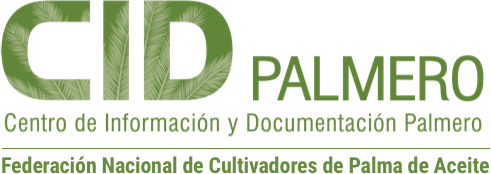Progress and research on Ganoderma basal stem rot of oil palm.

Author
Seminar on elevating National Oil Palm Productivity and Recent Progress in the Management of Peat and Ganoderma
Ariffin, Darus
Idris, Abu Seman
Estadisticas
Abstract
The basal stem rot (BSR) caused by species 01 Ganoderma, a basidiomycete fungus, remains as the major disease of oil palm in Malaysia and Indonesia. In Malaysia, serious incidence of BSR is no longer restricted only to plantations along the coast 01 Peninsular Malaysia, but has also been reported infecting oil palms planted in inland, lateritic and peat soils. It was recently reported that BSR disease does occur on oil palm growing in Sabah and Sarawak. With increasing reports on the incidence of BSR, the disease situation is becoming more acute and every effort should be mobilized in order to find a solution to this problem, mainly to reduce crop losses and to reduce costs of control practices. Investigation on the disease management to reduce the deleterious effects of BSR on oil palm production include the use of phytosanitation, applications of chemical fungicides, biological control, and the host resistance. Recommended management during replanting is destruction of the old palm tissues by pushing over the old stand and shredded into small fragments, all stumps and roots are extracted by digging a l.5m x 1.5m x 1.5m pit, and planting new palms away Irom former planting points, or in the inter-rows. Attempts to eradicate possible sources of Ganoderma using the soil fumigants have shown some promise, but the long-term effect is Jet to be determined. The role of fertilizer nutrients in disease control is that of stabilizing and strengthening the cell walls of the oil palm and stimulating the proliferation of antagonistic fungi that will compete for space and nutrients need to be further exploited. For control of Ganoderma in existing stand, the use of the pressure injection for application of fungicides and soil mounding are being investigated, and the results showed that these methods could prolong productivity of Ganoderma-infected palms, but the treatment was not proven to be curative. Recent successes with artificial inoculation of oil palm seedlings with Ganoderma open the avenue for screening for disease resistance. Significant variation in susceptibility was observed between 43 oil palm progenies following inoculation with an isolate of G. boninense in the nursery, indicating that some variation between plantations may be attributable to the seed sources. Research topics to augment knowledge on the biology and epidemiology of the Ganoderma and progress made on the biological control, with hope that disease management can be improved, and the loss caused by the BSR could possibly be brought under control. Incluye 100 referencias bibliográficas. The basal stem rot (BSR) caused by species 01 Ganoderma, a basidiomycete fungus, remains as the major disease of oil palm in Malaysia and Indonesia. In Malaysia, serious incidence of BSR is no longer restricted only to plantations along the coast 01 Peninsular Malaysia, but has also been reported infecting oil palms planted in inland, lateritic and peat soils. It was recently reported that BSR disease does occur on oil palm growing in Sabah and Sarawak. With increasing reports on the incidence of BSR, the disease situation is becoming more acute and every effort should be mobilized in order to find a solution to this problem, mainly to reduce crop losses and to reduce costs of control practices. Investigation on the disease management to reduce the deleterious effects of BSR on oil palm production include the use of phytosanitation, applications of chemical fungicides, biological control, and the host resistance. Recommended management during replanting is destruction of the old palm tissues by pushing over the old stand and shredded into small fragments, all stumps and roots are extracted by digging a l.5m x 1.5m x 1.5m pit, and planting new palms away Irom former planting points, or in the inter-rows. Attempts to eradicate possible sources of Ganoderma using the soil fumigants have shown some promise, but the long-term effect is Jet to be determined. The role of fertilizer nutrients in disease control is that of stabilizing and strengthening the cell walls of the oil palm and stimulating the proliferation of antagonistic fungi that will compete for space and nutrients need to be further exploited. For control of Ganoderma in existing stand, the use of the pressure injection for application of fungicides and soil mounding are being investigated, and the results showed that these methods could prolong productivity of Ganoderma-infected palms, but the treatment was not proven to be curative. Recent successes with artificial inoculation of oil palm seedlings with Ganoderma open the avenue for screening for disease resistance. Significant variation in susceptibility was observed between 43 oil palm progenies following inoculation with an isolate of G. boninense in the nursery, indicating that some variation between plantations may be attributable to the seed sources. Research topics to augment knowledge on the biology and epidemiology of the Ganoderma and progress made on the biological control, with hope that disease management can be improved, and the loss caused by the BSR could possibly be brought under control.
The basal stem rot (BSR) caused by species 01 Ganoderma, a basidiomycete fungus, remains as the major disease of oil palm in Malaysia and Indonesia. In Malaysia, serious incidence of BSR is no longer restricted only to plantations along the coast 01 Peninsular Malaysia, but has also been reported infecting oil palms planted in inland, lateritic and peat soils. It was recently reported that BSR disease does occur on oil palm growing in Sabah and Sarawak. With increasing reports on the incidence of BSR, the disease situation is becoming more acute and every effort should be mobilized in order to find a solution to this problem, mainly to reduce crop losses and to reduce costs of control practices. Investigation on the disease management to reduce the deleterious effects of BSR on oil palm production include the use of phytosanitation, applications of chemical fungicides, biological control, and the host resistance. Recommended management during replanting is destruction of the old palm tissues by pushing over the old stand and shredded into small fragments, all stumps and roots are extracted by digging a l.5m x 1.5m x 1.5m pit, and planting new palms away Irom former planting points, or in the inter-rows. Attempts to eradicate possible sources of Ganoderma using the soil fumigants have shown some promise, but the long-term effect is Jet to be determined. The role of fertilizer nutrients in disease control is that of stabilizing and strengthening the cell walls of the oil palm and stimulating the proliferation of antagonistic fungi that will compete for space and nutrients need to be further exploited. For control of Ganoderma in existing stand, the use of the pressure injection for application of fungicides and soil mounding are being investigated, and the results showed that these methods could prolong productivity of Ganoderma-infected palms, but the treatment was not proven to be curative. Recent successes with artificial inoculation of oil palm seedlings with Ganoderma open the avenue for screening for disease resistance. Significant variation in susceptibility was observed between 43 oil palm progenies following inoculation with an isolate of G. boninense in the nursery, indicating that some variation between plantations may be attributable to the seed sources. Research topics to augment knowledge on the biology and epidemiology of the Ganoderma and progress made on the biological control, with hope that disease management can be improved, and the loss caused by the BSR could possibly be brought under control.
Palabras clave:
Aplicación de fertilizantes
Control biológico
Control de enfermedades.
Edad.
Enfermedades de las plantas.
Epidemiología.
Ganoderma.
insectos vectores
pudrición basal del tallo
Rendimiento.
Resistencia a la enfermedad.
Síntomas
Tipos de suelos.
Palma de aceite
Aplicación de fertilizantes
Control biológico
Control de enfermedades.
Edad.
Enfermedades de las plantas.
Epidemiología.
Ganoderma.
insectos vectores
pudrición basal del tallo
Rendimiento.
Resistencia a la enfermedad.
Síntomas
Tipos de suelos.
Palma de aceite


